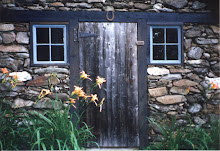EARTH ~
photo: w. eugene smith
W. EUGENE SMITH
Driven. Native of Kansas. An almost lifetime of amphetamine use & hard drinking kept up the drive to become one of the great photojournalists of the world.
Making legendary portraits of Schweitzer, Nurse Midwife, the terrible legacy and beatings near the end of his life withstood in the city of Minamata, Japan at the hands of thugs as he documented the flushing of heavy metals into the city's waters and the cause of Minamata Disease. The heartbreaking portraits of diseased children. Always directing his camera at innocence, tenderness, even his brutal shots from WW 2 or the working-class boroughs of UK.
Coming home to settle into a personal survey of Pittsburgh which would consume his life for three years...the job that was meant to take three weeks. Parting company with his employer Life Magazine and going to work at Magnum.
In 1957 W. Eugene Smith needed a place to hole-up as he tried to make sense of his massive photo-essay on Pittsburgh. He left everything behind — a fine home, wife and four children, and moved into a hustlers region of Manhattan, 4th floor. Then described as a dilapidated five-story loft building. The flower district by day; running with drugs, thieves, night-crawlers and musicians by night.
Smith had his head wrapped around Pittsburgh, but soon found out he was in one fascinating spot. Amongst the lofts and artists in his building he heard and saw and became friends with a whole new world too good to be true.
Thelonious Monk or Zoot Sims were visiting and playing upstairs, along with countless others unknown and terrific in the BeBop era, playing their hearts out night after night. The documentarian put his keen instincts to work. And this is all of a great book collected by Sam Stephenson, who seems a near equal with Smith in work horse ethics to get a portrait made. And the portrait is: our hero from 1957 to 1965 wired up the building where he lived — his room, hallways, other rooms as if his own private recording studio and made, count them! 1,740 reels of stereo and mono audiotapes. That's 4000 hours. And on those tapes are jam sessions supreme with Roy Haynes, Don Cherry, Alice Coltrane, Sonny Clark, Sonny Rollins, Bill Evans, Roland Kirk and many more. Conversations in street movement, passersby, sounds of an underground.
Smith's camera was never idle, even when one or two were in hock: he exposed 1,447 rolls of film making roughly 40,000 pictures. The beauties are in this book. Many shot right from Smith's dingy apartment window, around and about the building, in with the musicians jamming.
When anyone laments or whines, "But I'm only one man"— they're forgetting about W. Eugene Smith.
Making legendary portraits of Schweitzer, Nurse Midwife, the terrible legacy and beatings near the end of his life withstood in the city of Minamata, Japan at the hands of thugs as he documented the flushing of heavy metals into the city's waters and the cause of Minamata Disease. The heartbreaking portraits of diseased children. Always directing his camera at innocence, tenderness, even his brutal shots from WW 2 or the working-class boroughs of UK.
Coming home to settle into a personal survey of Pittsburgh which would consume his life for three years...the job that was meant to take three weeks. Parting company with his employer Life Magazine and going to work at Magnum.
In 1957 W. Eugene Smith needed a place to hole-up as he tried to make sense of his massive photo-essay on Pittsburgh. He left everything behind — a fine home, wife and four children, and moved into a hustlers region of Manhattan, 4th floor. Then described as a dilapidated five-story loft building. The flower district by day; running with drugs, thieves, night-crawlers and musicians by night.
Smith had his head wrapped around Pittsburgh, but soon found out he was in one fascinating spot. Amongst the lofts and artists in his building he heard and saw and became friends with a whole new world too good to be true.
Thelonious Monk or Zoot Sims were visiting and playing upstairs, along with countless others unknown and terrific in the BeBop era, playing their hearts out night after night. The documentarian put his keen instincts to work. And this is all of a great book collected by Sam Stephenson, who seems a near equal with Smith in work horse ethics to get a portrait made. And the portrait is: our hero from 1957 to 1965 wired up the building where he lived — his room, hallways, other rooms as if his own private recording studio and made, count them! 1,740 reels of stereo and mono audiotapes. That's 4000 hours. And on those tapes are jam sessions supreme with Roy Haynes, Don Cherry, Alice Coltrane, Sonny Clark, Sonny Rollins, Bill Evans, Roland Kirk and many more. Conversations in street movement, passersby, sounds of an underground.
Smith's camera was never idle, even when one or two were in hock: he exposed 1,447 rolls of film making roughly 40,000 pictures. The beauties are in this book. Many shot right from Smith's dingy apartment window, around and about the building, in with the musicians jamming.
When anyone laments or whines, "But I'm only one man"— they're forgetting about W. Eugene Smith.
W. Eugene Smith (1918-1978)-----------www.pbs.org










































